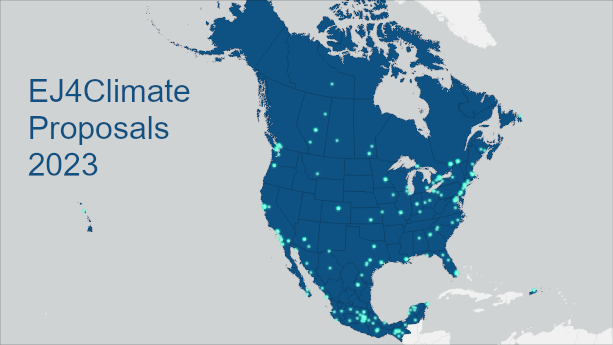What is the EJ4Climate Grant Program?
The CEC established this grant program in 2021 to fund projects that target underserved and vulnerable communities, and Indigenous communities, in Canada, Mexico, and the United States, to prepare them for climate-related impacts.
The EJ4Climate Grant Program provides funding directly to community-based organizations and seeks to support environmental justice by facilitating the involvement and empowerment of communities searching for solutions and the development of partnerships to address their environmental and human health vulnerabilities, including those due to climate change impacts.
Community empowerment strategies to improve resilience to extreme weather events in urban settings
For the third grant cycle of EJ4Climate launched in September 2023, the CEC called for project proposals that will advance community-driven strategies in support of environmental justice and community resilience to the impacts of extreme weather events in urban areas. In North America, approximately 80% of people live in urban areas, making urban environments the space and framework through which much of today’s climate change, and responses to it, unfolds and therefore could result in greater impacts.
In compliance with the theme, the selected projects will be implemented in overburdened communities in urban areas. The community-driven strategies will integrate empowerment as the main principle to support and enable communities and individuals to gain more influence and implement long-lasting solutions to strengthen resilience to extreme weather events and reduce the current disproportionate and adverse health, economic and social impacts.

Community Response to the EJ4Climate Grant Program
The third cycle of the EJ4Climate Grant Program concluded with the selection of 13 grant recipients representing a range of communities in Canada, Mexico, and the United States. The 2023-2024 cycle, which received over 240 compelling proposals, acts as a strong indicator of the value of programs that support communities with environmental justice concerns in their efforts to foster climate resilience.
General concepts
“Even though there is no internationally accepted definition, environmental justice broadly covers fair and inclusive engagements of all in the development, implementation and enforcement of environmental legislation. It, therefore, refers directly to access to environment-related goods, such as clean water and energy or safe urban areas, or to protection from negative environmental pressures, like air and water pollution or deforestation (distributional justice). It also translates into equal access to the decision-making process of environmental policies (procedural justice). Finally, it has been argued that environmental justice should also achieve a healthy environment for all (substantive justice).”1
Environmental Justice can also be understood as “the fair treatment and meaningful involvement of all people with respect to the development, implementation, and enforcement of environmental laws, regulations, and policies.”2
In Mexico, the concept of environmental justice is broader and entails, among other things, efforts to reach an equal distribution of environmental benefits and costs. Environmental justice also entails obtaining a timely legal solution to a given environmental conflict, considering that all people must start from the same conditions to access environmental justice.3 The Government has to promote greater social equity in the distribution of costs and benefits associated with environmental policy objectives.4
1 OECD, “Session 7 Environmental justice and empowering women and youth,” p. 2, 2020 Global Forum on Environment (internal citations omitted).
2 https://www.epa.gov/environmentaljustice
3 https://www.dof.gob.mx/nota_detalle.php?codigo=5596232&fecha=07/07/2020#gsc.tab=0
4 https://www.diputados.gob.mx/LeyesBiblio/pdf/LGEEPA.pdf
We understand “underserved communities” as “populations sharing a particular characteristic, as well as geographic communities, that have been systematically denied a full opportunity to participate in aspects of economic, social, and civic life…”and includes individuals “such as Black, Latino, and Indigenous and Native American persons, Asian Americans, and Pacific Islanders and other persons of color; members of religious minorities; lesbian, gay, bisexual, transgender, and queer (LGBTQ+) persons; persons with disabilities; persons who live in rural areas; and persons otherwise adversely affected by persistent poverty or inequality.”5
See also California’s definition of “climate vulnerability” developed for its Integrated Climate Adaptation and Resiliency Program.6
“Overburdened communities” refers to minority, low-income, tribal, or Indigenous populations or geographic locations that potentially experience disproportionate environmental harms and risks.7
In Mexico, it refers to communities with a precarious structure of opportunities that obstructs the full development of human potential derived from the lack of access to education, residence in inadequate housing, low monetary income and those derived from residence in inadequate localities.
Urban areas are understood as cities, towns and suburban or peri-urban areas who have greater vulnerability to environmental hazards.
In the World Cities Report 20228, the UN-Habitat refers to the Degree of Urbanization methodology that offers more nuance than the “urban” and “rural” binary that commonly categorizes the demographic classification of human settlements. Instead of those two categories, this approach proposes to analyze grid cells of one square kilometer (1 sq. km) as below:
- Cities: settlements of at least 50,000 inhabitants in a high-density cluster of grid cells (greater than 1,500 inhabitants per sq. km).
- Towns: settlements with between 5,000 and 50,000 that are either dense (with a density of at least 1,500 inhabitants per sq. km) or semi-dense (a density at least 300 inhabitants per sq. km).
- Suburban or peri-urban areas: cells belonging to urban clusters but not part of a town.

